
The Passiontinde window depicts the instruments of the Crucifixion and of the suffering of Christ.
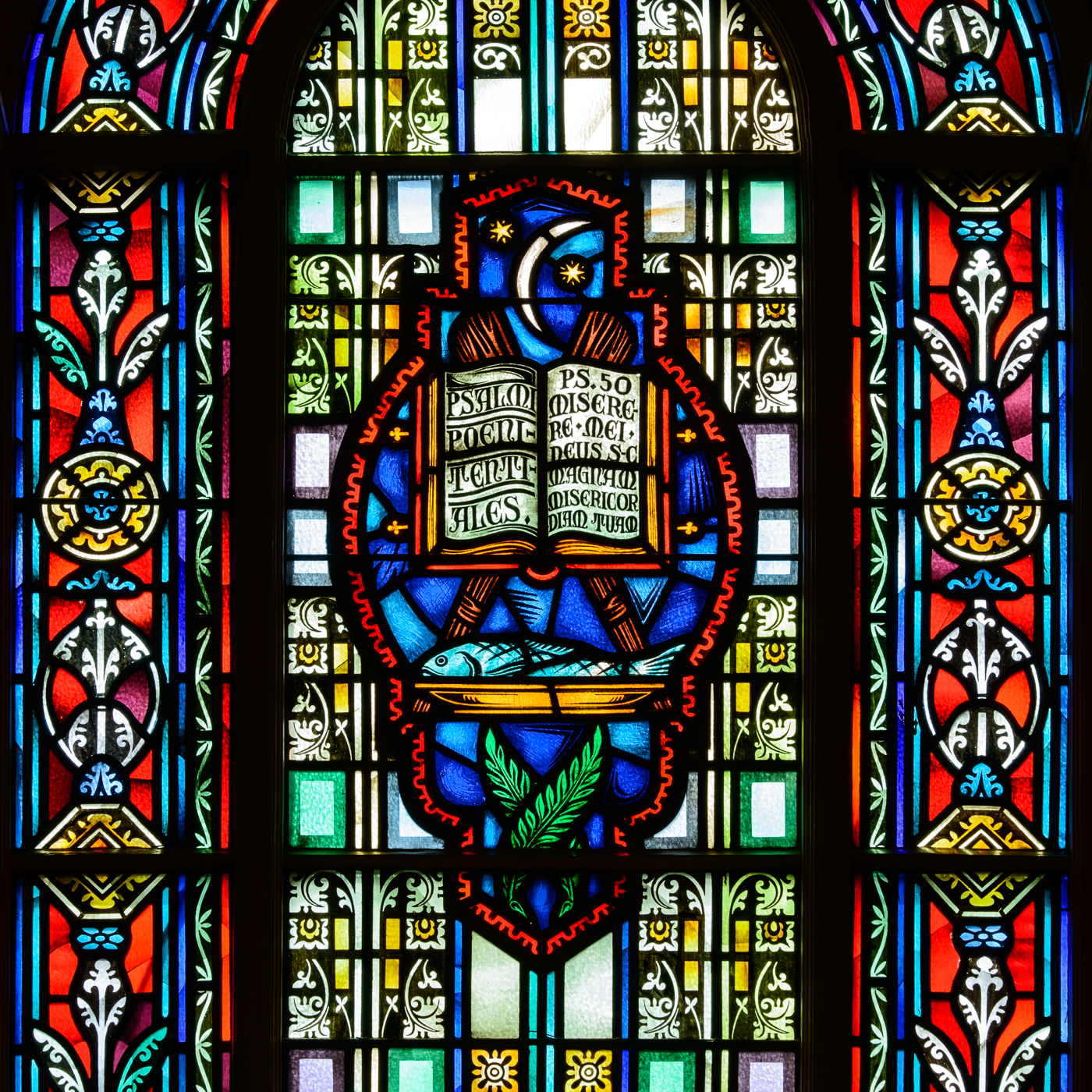
The Lent window indicates the duties of a Catholic during the Lenten Season,
The open book with the Penitential Psalms should remind the Catholic of meditation during this time.
The two bundles of rods remind us of penance.
The fish indicates abstinence.
The stars and the moon are indicative of the night vigils of old. The palm fronds signify the reward of victory.
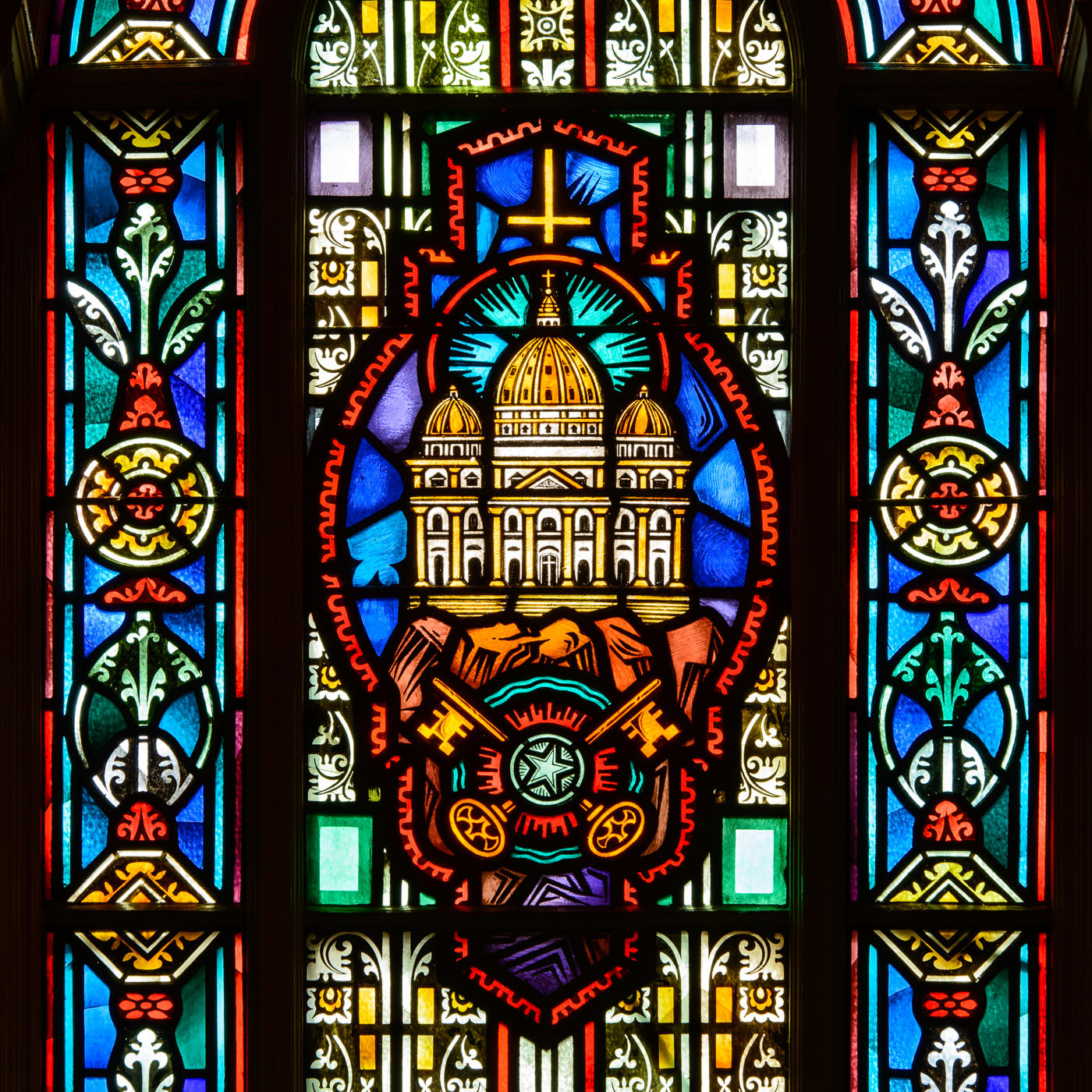
The St. Peter's Chair window represents the feast day of St. Peter's Chair. The church celebrates the day of St. Peter's coming to Rome and establishing the papal throne.
The window shows the dome of St. Peter whose strength and everlasting foundation is indicated through the rock on which the church rests.
Above the dome, the cross on which St. Peter was crucified, head downwards, appears as a symbol of his martyrdom. The two keys underneath represent the power invested in St. Peter by Christ.
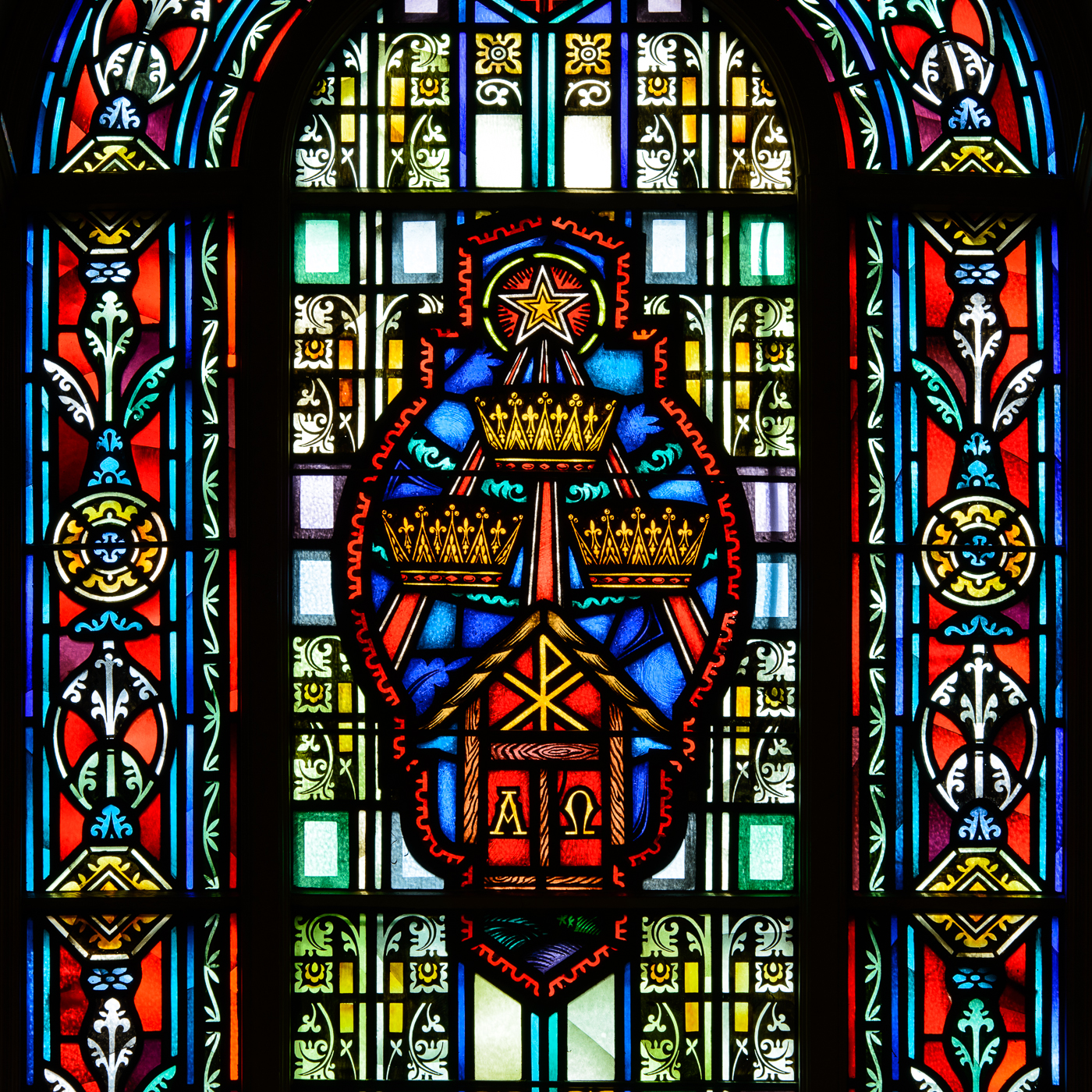
The Epiphany window.
The three crowns symbolize the Wise Men of the East and the five cornered star in the center represents the Star of Epiphany. The symbol underneath indicates the Stable of Bethlehem.
The presence of Christ in the stable is indicated through the large XP (Chi Rho), and through the first and last letters of the Greek alphabet, Alpha and Omega, is indicated that in Christ is the beginning and end.
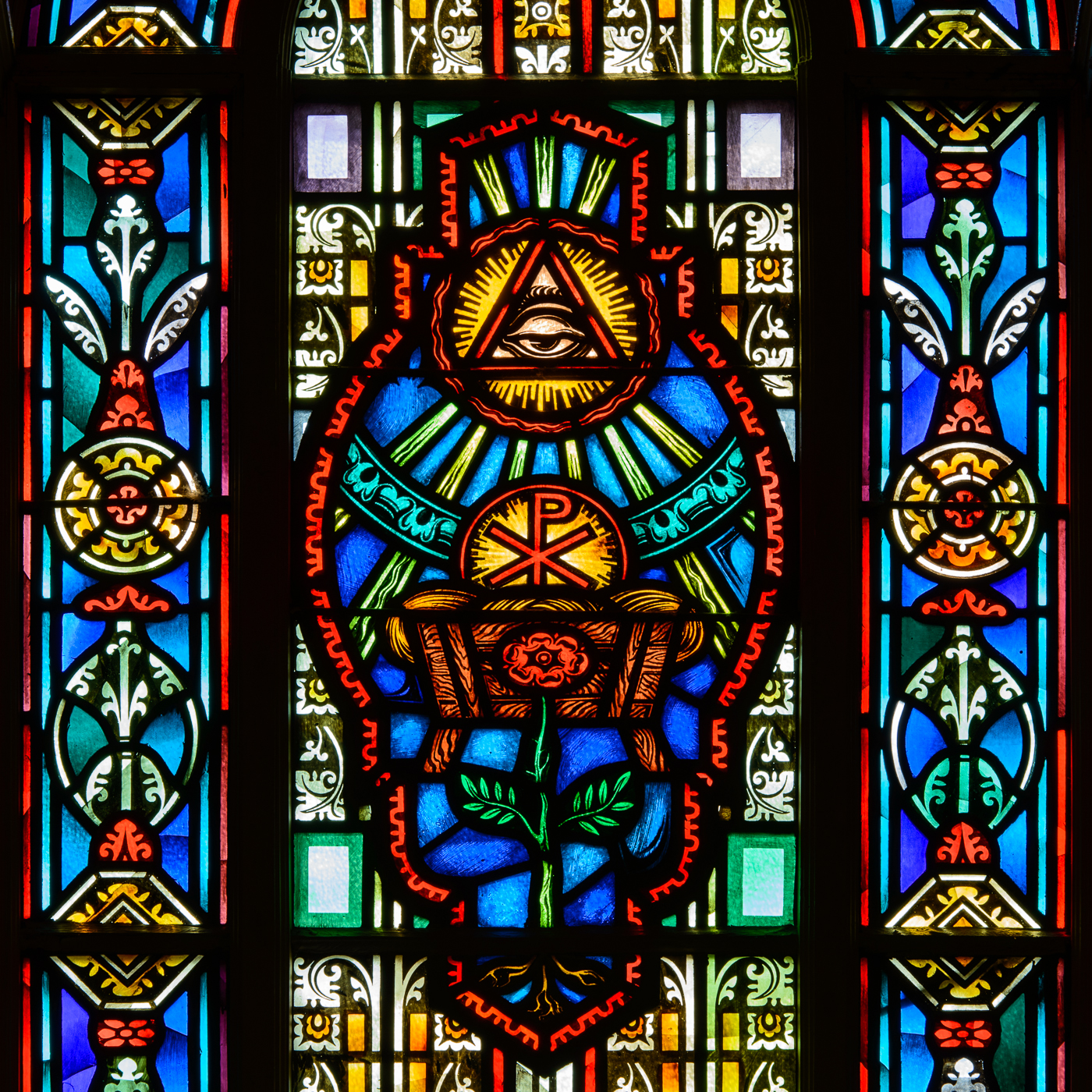
The Christmas window indicates that the promise of God the Father is fulfilled.
The all-seeing eye of God, surrounded by a halo, indicates God the Father. The XP (Chi Rho) above the crib indicates the Christ Child.
The Mystical Rose in the center of the crib represents the Blessed Virgin, and the Root of Jesse, which springs from the earth, indicates the human body of Christ.
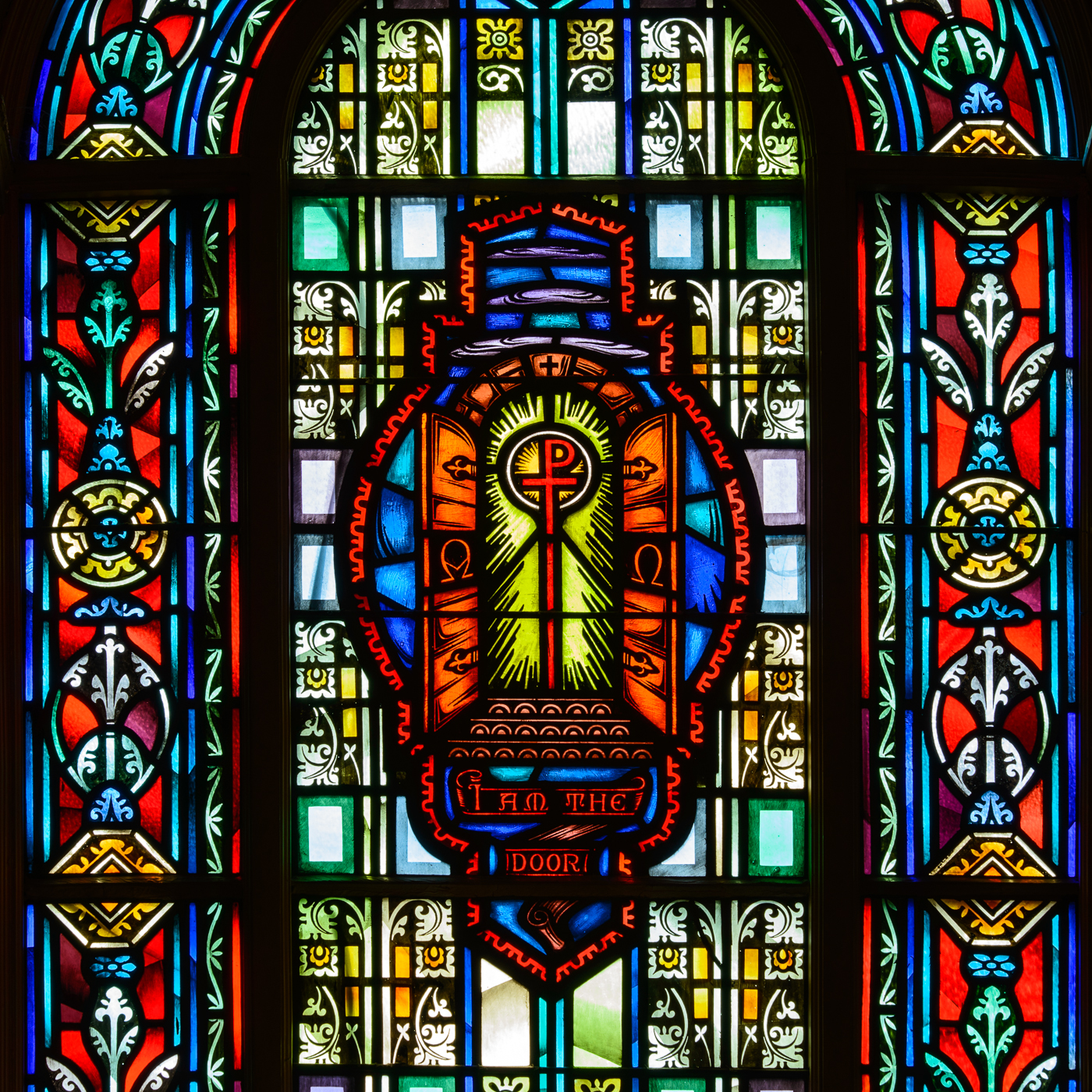
The Rejoice Sunday window.
The principal thought of this Sunday is "the Lord is near." The mystical presence of Christ is indicated through the XP (Chi Rho) and in the background the light of Christmas radiates into the night.
The words, "I am the Door" refer to John 10: 7 where Jesus promises "Whoever will enter through me will be saved."

The Advent window.
The ruins indicate darkness and desolation on earth before the birth of Christ; humanity longs for salvation.
The Greek letters in radiating sun, surrounded by brilliant rays, indicate the words, "Life and Light" symbolizing the Messianic Promise, and indicate that new life through the heralded birth of Christ is to be brought to mankind.
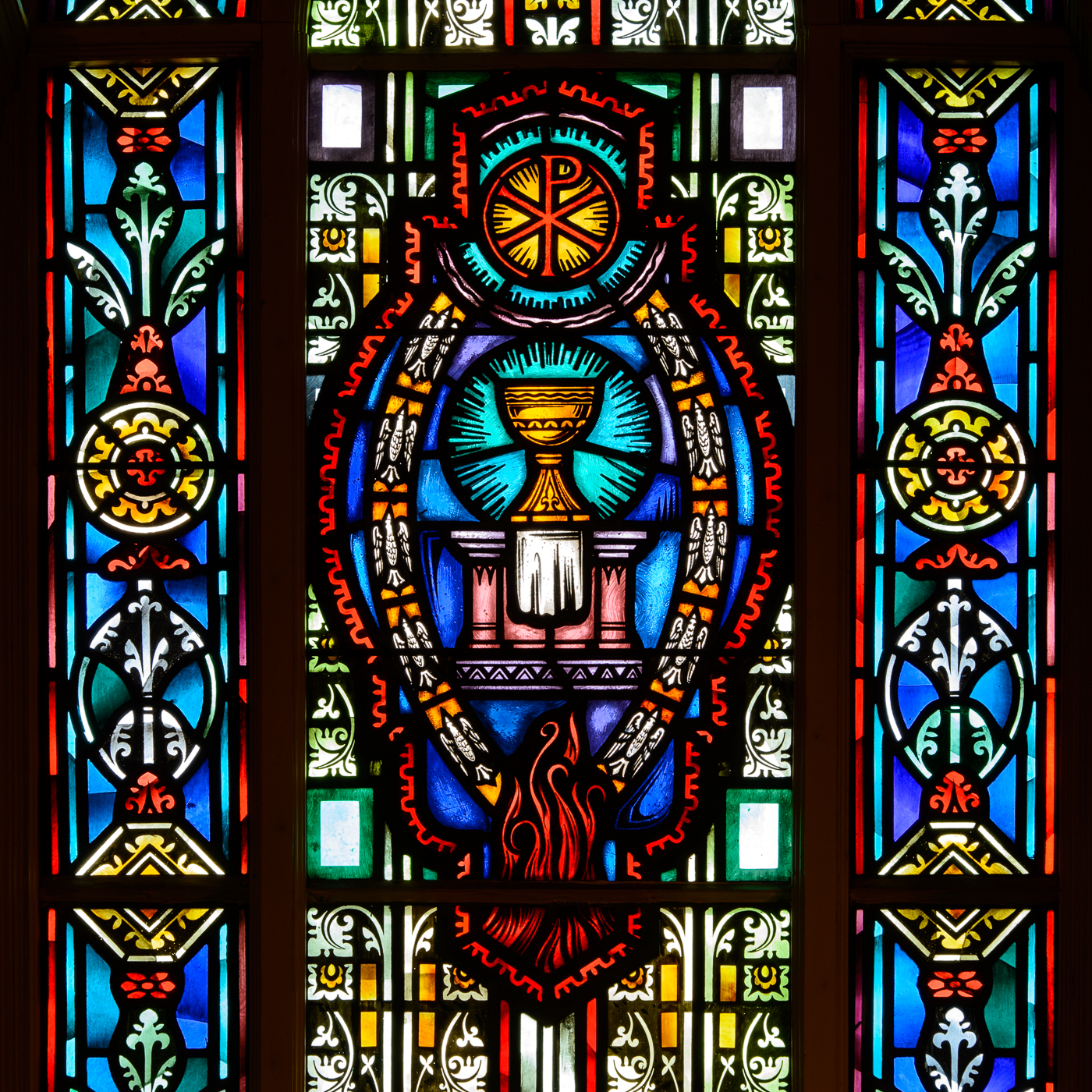
The All Souls window depicts the release from purgatory of the poor souls through the sacrifice of the Mass.
Purgatory is indicated through flames, out of which rises a flight of white doves, indicating the souls of the departed, towards heaven, to be finally united with Christ.
The symbol is a reminder for us that continuous prayer and offering of the Mass are the duties of every Catholic towards the departed ones.
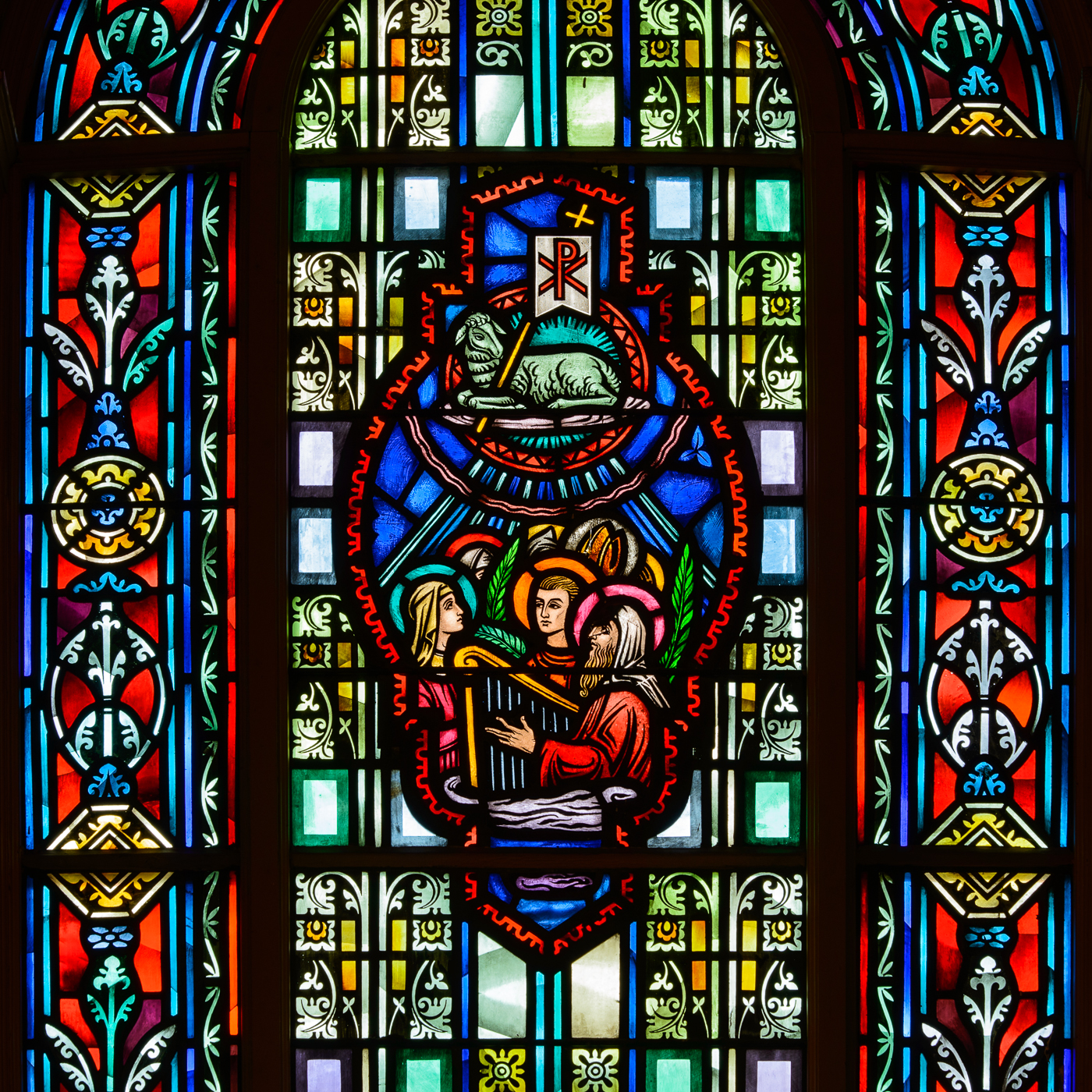
The All Saints window indicates, above all, Christ in the form of a lamb in His glory in heaven.
The symbol further shows one of the prophets with a harp, leading representatives of the choirs of the saints, comprising martyrs. virgins, widows, bishops, in a continuous praise.
This indicates the heavenly atmosphere for those who lived and died in Christ.
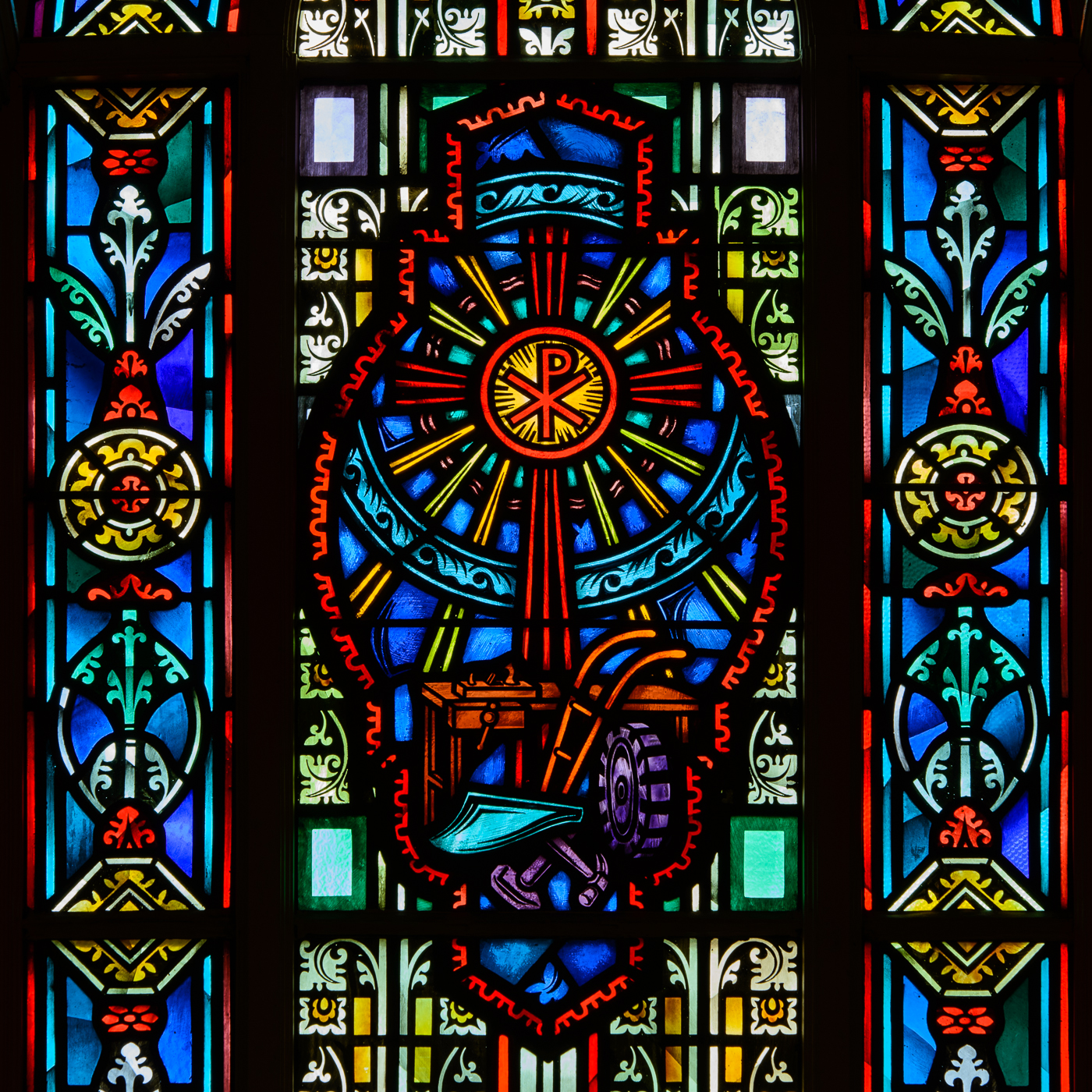
The Christ the Worker window is a special contribution of Monsignor Joseph Aughney in foreseeing the establishment of the special feast day of Christ the Worker, indicating how capital and labor through the Kingship of Christ will ultimately be united.
Agricultural workers are indicated through the plow, industrial workers through the wheels and sledge hammer. The carpenter's bench with plane illustrates the occupation of Christ as a worker in His youth assisting St. Joseph.
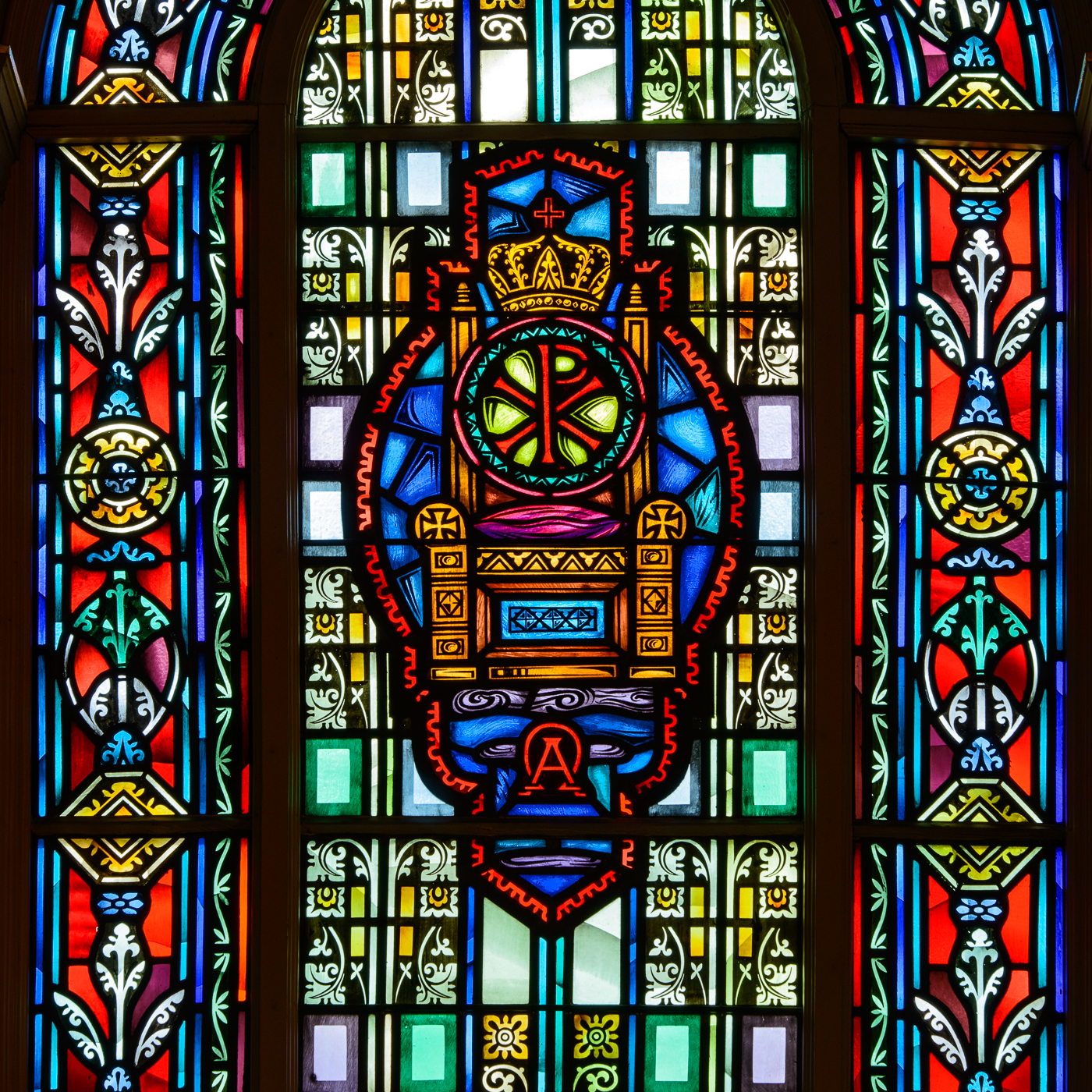
The Christ the King window illustrates Christ the King in heaven, symbolized through the throne.
As the symbols are purposely avoiding any representation in human figures, the presence of Christ on the throne is indicated by XP, (the Greek letters Chi and Rho), surrounded by a halo. The crown above further indicates Christ as the King of all Kings.
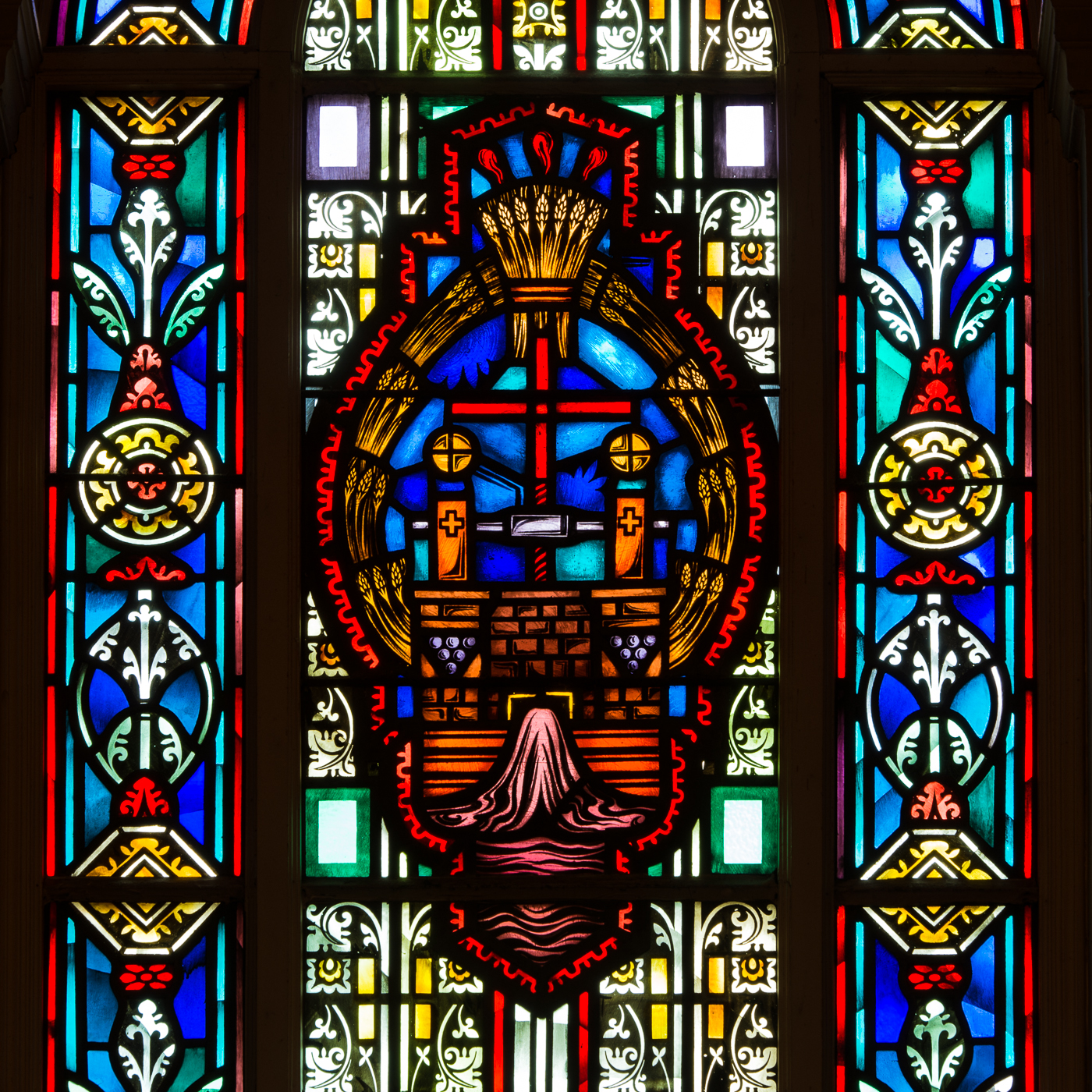
The Corpus Christi window seeks to illustrate the vineyard of the Church. The center illustrates the wine press, also indicating the altar on which the transition of the wine into the Blood of Christ takes place. The mystical wine streams for us from the altar in the Mass and provides a continuous stream of heavenly grace to the faithful.

The Pentecost window commemorates the coming of the Holy Spirit to the Apostles assembled in the same room where Christ celebrated the Last Supper, which is further illustrated by the table underneath the arches.
There are 13 fiery tongues, representing the Blessed Virgin and the 12 Apostles. The chalice is a supplementary symbol reminding us of the continuous repetition of the Last Supper in the Sacrifice of the Holy Mass.
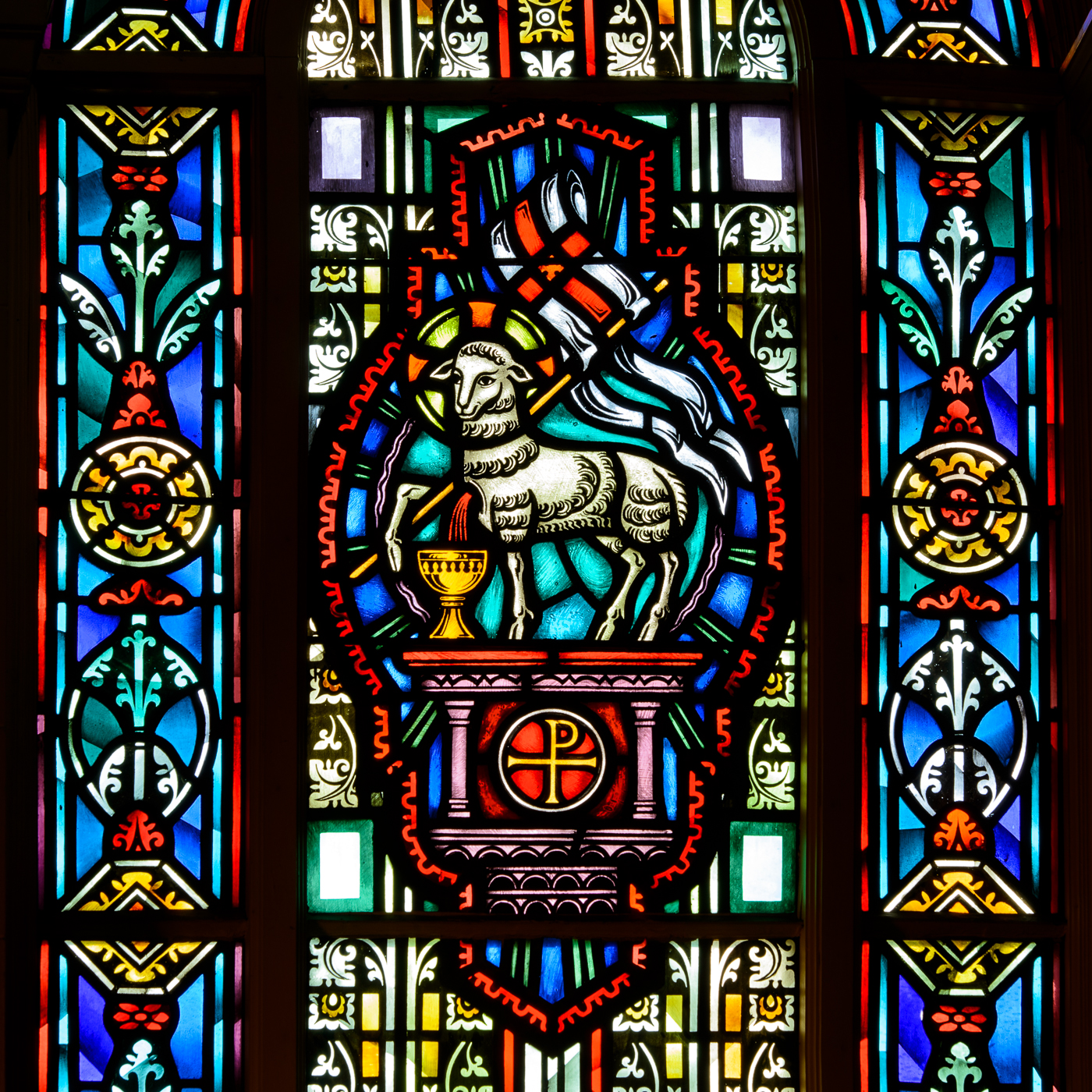
The Easter window. Christ in Victory, represented through the Lamb with the Easter Banner, indicates the victory of Christ over death.
The altar on which the lamb stands represents the sacrifice of Christ, which is further indicated through a chalice into which the blood of the lamb flows. It also indicates continuous sacrifice celebrated anew through the Holy Mass every day.














The Passiontinde window depicts the instruments of the Crucifixion and of the suffering of Christ.
The Lent window indicates the duties of a Catholic during the Lenten Season,
The open book with the Penitential Psalms should remind the Catholic of meditation during this time.
The two bundles of rods remind us of penance.
The fish indicates abstinence.
The stars and the moon are indicative of the night vigils of old. The palm fronds signify the reward of victory.
The St. Peter's Chair window represents the feast day of St. Peter's Chair. The church celebrates the day of St. Peter's coming to Rome and establishing the papal throne.
The window shows the dome of St. Peter whose strength and everlasting foundation is indicated through the rock on which the church rests.
Above the dome, the cross on which St. Peter was crucified, head downwards, appears as a symbol of his martyrdom. The two keys underneath represent the power invested in St. Peter by Christ.
The Epiphany window.
The three crowns symbolize the Wise Men of the East and the five cornered star in the center represents the Star of Epiphany. The symbol underneath indicates the Stable of Bethlehem.
The presence of Christ in the stable is indicated through the large XP (Chi Rho), and through the first and last letters of the Greek alphabet, Alpha and Omega, is indicated that in Christ is the beginning and end.
The Christmas window indicates that the promise of God the Father is fulfilled.
The all-seeing eye of God, surrounded by a halo, indicates God the Father. The XP (Chi Rho) above the crib indicates the Christ Child.
The Mystical Rose in the center of the crib represents the Blessed Virgin, and the Root of Jesse, which springs from the earth, indicates the human body of Christ.
The Rejoice Sunday window.
The principal thought of this Sunday is "the Lord is near." The mystical presence of Christ is indicated through the XP (Chi Rho) and in the background the light of Christmas radiates into the night.
The words, "I am the Door" refer to John 10: 7 where Jesus promises "Whoever will enter through me will be saved."
The Advent window.
The ruins indicate darkness and desolation on earth before the birth of Christ; humanity longs for salvation.
The Greek letters in radiating sun, surrounded by brilliant rays, indicate the words, "Life and Light" symbolizing the Messianic Promise, and indicate that new life through the heralded birth of Christ is to be brought to mankind.
The All Souls window depicts the release from purgatory of the poor souls through the sacrifice of the Mass.
Purgatory is indicated through flames, out of which rises a flight of white doves, indicating the souls of the departed, towards heaven, to be finally united with Christ.
The symbol is a reminder for us that continuous prayer and offering of the Mass are the duties of every Catholic towards the departed ones.
The All Saints window indicates, above all, Christ in the form of a lamb in His glory in heaven.
The symbol further shows one of the prophets with a harp, leading representatives of the choirs of the saints, comprising martyrs. virgins, widows, bishops, in a continuous praise.
This indicates the heavenly atmosphere for those who lived and died in Christ.
The Christ the Worker window is a special contribution of Monsignor Joseph Aughney in foreseeing the establishment of the special feast day of Christ the Worker, indicating how capital and labor through the Kingship of Christ will ultimately be united.
Agricultural workers are indicated through the plow, industrial workers through the wheels and sledge hammer. The carpenter's bench with plane illustrates the occupation of Christ as a worker in His youth assisting St. Joseph.
The Christ the King window illustrates Christ the King in heaven, symbolized through the throne.
As the symbols are purposely avoiding any representation in human figures, the presence of Christ on the throne is indicated by XP, (the Greek letters Chi and Rho), surrounded by a halo. The crown above further indicates Christ as the King of all Kings.
The Corpus Christi window seeks to illustrate the vineyard of the Church. The center illustrates the wine press, also indicating the altar on which the transition of the wine into the Blood of Christ takes place. The mystical wine streams for us from the altar in the Mass and provides a continuous stream of heavenly grace to the faithful.
The Pentecost window commemorates the coming of the Holy Spirit to the Apostles assembled in the same room where Christ celebrated the Last Supper, which is further illustrated by the table underneath the arches.
There are 13 fiery tongues, representing the Blessed Virgin and the 12 Apostles. The chalice is a supplementary symbol reminding us of the continuous repetition of the Last Supper in the Sacrifice of the Holy Mass.
The Easter window. Christ in Victory, represented through the Lamb with the Easter Banner, indicates the victory of Christ over death.
The altar on which the lamb stands represents the sacrifice of Christ, which is further indicated through a chalice into which the blood of the lamb flows. It also indicates continuous sacrifice celebrated anew through the Holy Mass every day.
